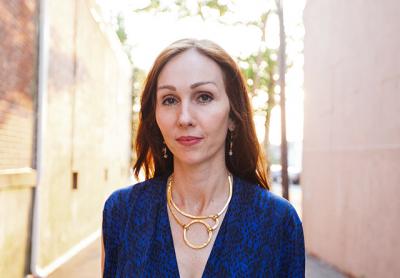First Day at Guild Hall for Andrea Grover

Today is Andrea Grover’s first day as executive director of Guild Hall, replacing Ruth Appelhof, who is retiring. Ms. Grover, who comes to Guild Hall as an active member of the East End arts community, has already helped transform one local institution, the Parrish Art Museum, where she was curator of special projects for several years and was responsible for this summer’s popular “Radical Seafaring” exhibition.
Days before she would actually set foot in Guild Hall as its captain, it was easy to speak with her about the general state of the arts and her broad vision for the East Hampton institution, but it was not yet the time or place for specifics. “I’m sorry to be the worst interview ever,” she said during lunch at c/o the Maidstone last week, with no need to apologize. Over heirloom tomato salads and a shared bowl of French fries, she did outline some initiatives she means to try and some feedback she has already received from the community.
As she remarked, smiling, at Guild Hall’s Summer Gala party two weeks ago, many people feel strongly about the place and some even more so about replacing the carpet in the museum galleries. (She promised the crowd that she would look into it.) Of more personal concern to her is the flight of youth from the community and the difficulties young artists have in finding both work and living spaces in a real estate market as inflated as the South Fork’s.
She is particularly excited about Guild Hall’s new Artists in Residence program, which is designed to attract young creative people to complete work here and discover the special nature of the place, in the hope that they might choose to remain. And she loves Guild House, where the artists live during their time here. She said the space offers “another setting for public programs, but with an intimate feeling, a living room for dialogues and exchanges,” as well as the residency. She would like to see it used for theatrical presentations as well, or for art installations or other immersive environments.
A program at Minneapolis’s Walker Art Center in which her husband, Carlos Lama, participated, suggested to her another approach to the problem of youth flight. The Walker’s teen council program interviews and hires high school students as paid employees, to participate in workshops and education programs that result in fashion shows, exhibitions, battles of the bands, and other presentations that give teenagers a chance to work within their own areas of interest. The teen council members whom Mr. Lama advised are still in touch with him. One is now an editor at Rolling Stone magazine; another has become prominent in the fashion industry. The program “really solidified where they were going” in their future careers, Ms. Grover said. “People will come back here if they have ties to the community and to its institutions.”
Some of her best work at the Parrish involved getting people out of the museum to enjoy art in other places, some familiar, others unusual. She’s leaving those programs, such as the Parrish Road Show and the Platform series, with her former employer, but she intends to introduce similar projects at Guild Hall, bringing museum patrons out of the galleries to examine art in new and different environments.
PechaKucha, a hugely popular event first devised in Japan that brings residents together several times a year to share their life stories and creative quests through a focused set of slide presentations, will also remain at the Parrish. “I signed the PechaKucha license over to Terrie [Sultan, the Parrish’s director]. Having known and worked with her for more than a decade, it was paramount to me that that relationship be preserved.”
Ms. Grover expects to work collaboratively with Ms. Sultan. “We should embrace our differences but find out where there are similarities and band together,” she said. She pointed to a 2008 Robert Rauschenberg retrospective in Houston where three institutions shared and buses took viewers from venue to venue, as something that could occur here under the right circumstances.
As to her new employers, she said the experience of interviewing and getting to know Guild Hall and its board of directors had been key in her decision to take the leap. In addition to the high degree of commitment and involvement of the board and its chairman, Marty Cohen, she said Ms. Appelhof had been “absolutely wonderful in welcoming me. She called me within five minutes of the announcement and gave me her cell number and told me to call her anytime.”
In an email this week, Mr. Cohen was effusive in praising Ms. Grover’s talent, experience, and reputation in the East End community.
The new director, who has already done a great deal of information-gathering, said that much of her time in the next few months will be spent on doing still more. “For me, it’s about understanding the global vision, the 360-degree view. How does the theater relate to the exhibition program, and how does the education program relate back to them.”
“I love the name Guild Hall,” she said. “It signifies a gathering space and conversations that happen at a high level. There is the potential there for it to be a think tank,” with a topical series like the Hamptons Institute, but across the institution in its other disciplines as well.
She made it clear, though, that artists — performing, visual, literary, musical, and otherwise — will continue to lead the way, as they always have.
